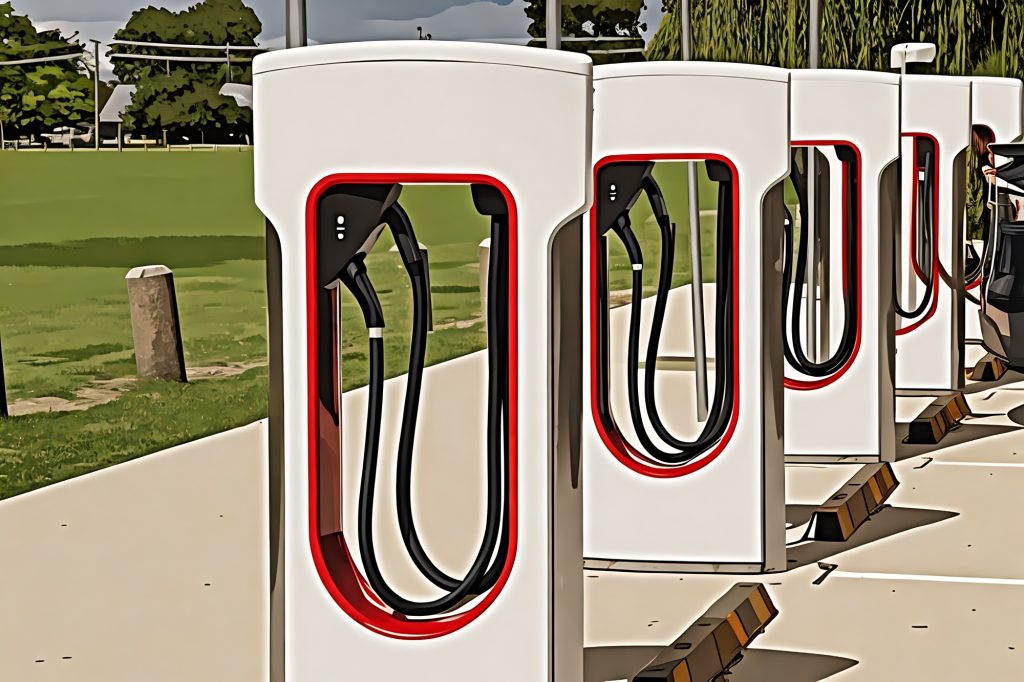Major U.S. electric utilities are embarking on an unprecedented surge in capital expenditures to modernize and expand transmission and distribution infrastructure. The driving force is a boom in electricity demand from newly emergent, power-hungry sectors – notably artificial intelligence (AI) data centers and electric vehicles (EVs). A recent analysis found that about nine U.S. utilities had raised their capital spending forecasts by an average of 22% for 2025-2027, marking a strategic shift for an industry that until recently saw relatively flat load growth. Utilities are now racing to beef up the grid’s capacity and reliability to support the digital economy and electrified transport of the future.
High-voltage transmission lines at dusk set the stage for understanding the scale of this transformation. U.S. utilities are dramatically increasing their investment in grid infrastructure to meet rising power demand from AI data centers and EV charging. This trend is exemplified by steep hikes in long-term investment plans at many leading power companies. For instance, a Kansas-Missouri utility announced its largest capex revision since 2018 by boosting its rolling five-year investment plan by $3.7 billion, representing a significant increase. Likewise, multi-state giant American Electric Power (AEP) revised its five-year plan to $54 billion, a sizable jump that underscores a bullish forecast for power demand. These hefty budget increases, coming on the heels of similar moves by peers, underline how emerging technology sectors have upended traditional utility planning. Utilities are proactively pouring billions into upgrading electric transmission and distribution infrastructure to serve tomorrow’s AI and EV-driven demand.
Drivers of Surging Capital Investment in the Grid
Modern data centers, particularly those harnessing AI capabilities, have emerged as a key catalyst for the surge in spending. After nearly two decades of stagnant power demand, U.S. utilities have seen an explosion in load growth driven by the breakthrough of generative AI and the subsequent data center boom. AI-focused server farms require massive amounts of electricity to power processors and cooling systems around the clock. These data centers are now estimated to account for a large portion of U.S. electricity load growth over the next several years, leading utilities to plan for steep increases in power consumption in certain regions. In practical terms, one large AI data center can equate to the power needs of tens of thousands of homes. To prevent capacity shortfalls, utilities aggressively add new substations, expand high-voltage transmission lines, and reinforce infrastructure in key data center hubs.
Electric vehicle adoption is the second major driver prompting increased grid investments. As automakers roll out more EV models and sales surge, cumulative charging loads are projected to increase electricity demand significantly. Although this increase might appear modest at the national level, the impact is magnified in localized areas with high EV uptake. Utilities are upgrading distribution transformers, feeders, and interconnection points for charging infrastructure to ensure reliable service. Moreover, improvements in transmission links are becoming necessary to connect fast-charging highway stations and to reinforce urban grids, where clusters of home charging stations can overload aging equipment. This electrification of transportation is compelling utilities to expand their capacity well before millions of EVs hit the roads.
These developments occur in the context of a historic lull in demand, where past growth was offset by efficiency gains and shifts in industrial activity. However, the convergence of AI and data center expansion, vehicle electrification, and renewed domestic manufacturing is fundamentally changing the dynamics of power consumption. Projections of record-high electricity demand over the next several years have shaken utility planners, who now regard this as a long-term structural shift. Utilities are rethinking strategy: rather than managing stagnation, they plan for a future where the electric grid is a robust enabler of technological progress and economic innovation.
Utility Responses: Record-High Grid Spending Plans
In response to surging demand, virtually every large U.S. utility has unveiled an ambitious capital spending roadmap to modernize the grid. Over the past few months, several investor-owned utilities have significantly raised their multi-year capital expenditure forecasts. Many of these updates set all-time highs for the companies’ investment levels.
A striking example is provided by Evergy, which serves Kansas and Missouri. Citing robust industrial growth and new data center projects in its territory, Evergy increased its five-year investment budget to fund new transmission lines, substation expansions, and distribution upgrades that will accommodate large new customers. Similarly, American Electric Power, one of the nation’s largest utilities with operations spanning 11 states, has committed to a $54 billion five-year capital plan—its most aggressive expansion in recent memory. Executives highlighted that much of this increase is directed toward bolstering transmission projects and reinforcing grid resilience to meet growing demands from electrification. Some companies have even signaled that further funds might be invested should opportunities continue to emerge.
Region-specific examples further illustrate the national pivot. Dominion Energy, which serves the data center–heavy region of Northern Virginia, raised its planned capital expenditures for 2025–2029 to address rapidly expanding data center build-outs. Executives emphasized that booming demand has necessitated a substantial increase in investment to keep pace with the growth of mega-data centers. Meanwhile, Duke Energy, servicing parts of the Southeast, unveiled an expanded five-year capital plan to support grid improvements in areas experiencing new industrial projects and burgeoning data center activity. The collective response is a clear declaration from the utility sector: substantial investment in grid infrastructure is imperative to capture new revenue from emerging high-demand customers and safeguard existing service reliability.
Infrastructure Challenges on the Road Ahead
While utilities have committed to unprecedented spending levels, executing these projects poses significant challenges. Building electric infrastructure at scale is fraught with practical and regulatory obstacles that could slow progress or elevate costs.
One significant challenge arises from regulatory and rate pressures. Utilities traditionally recover investment costs through electricity rates, meaning that substantial capital outlays eventually translate into consumer rate increases. Consumer advocates and regulatory bodies are increasingly vigilant, scrutinizing sharp rate hikes and calling for transparency in justifying these investments. Rate cases can be unpredictable; if a utility’s proposed rate increase is not fully approved, it may be forced to trim its capex plans, potentially compromising grid expansion timelines. To mitigate these risks, some utilities are exploring alternatives such as federal grants or public-private partnerships to finance their projects while easing the immediate impact on consumers.
Supply chain bottlenecks also loom large over the ambitious grid build-out plans. The global supply chain for electrical components—including distribution transformers, high-voltage switchgear, and specialized conductor materials—is already under strain. U.S. utilities face longer lead times and higher costs as demand outstrips available supply. In some cases, a shortage of critical items like transformers has created delays that could hinder timely project completion. Labor shortages compound these delays; constructing new transmission lines and substations requires a skilled electrical engineering and construction workforce, a resource currently in short supply. Despite efforts to ramp up manufacturing and train more workers, supply chain and workforce constraints remain a persistent risk factor.
Permitting and siting hurdles add another layer of complexity to the ambitious capex plans. Large transmission projects often face protracted permitting processes and community opposition. Securing rights-of-way for high-voltage lines can involve years of negotiations with multiple governmental agencies and local stakeholders. Environmental impact assessments, public hearings, and regulatory reviews introduce additional uncertainties that may delay project approval and completion. If infrastructure projects are delayed due to permitting challenges, utilities could struggle to keep pace with rapidly growing demand, potentially risking grid reliability during the transition.
Maintaining system reliability during extensive grid upgrades is another critical concern. Integrating large new loads, such as a 300 MW data center, requires careful load management strategies to ensure the existing grid remains stable while upgrading. Utilities are exploring interim solutions to mitigate these transitional stresses, including mobile transformers and temporary circuit reconfigurations. Simultaneously, efforts to enhance grid resilience against natural disasters like severe storms, wildfires, and extreme heat are being integrated into capital plans. Although these measures are essential for long-term reliability, they also contribute to the overall complexity of the grid upgrade process. The challenge for utilities is to synchronize the rollout of new infrastructure while maintaining stable service for all customers.
Global Trends and Comparisons
U.S. utility spending is occurring against a backdrop of significant investment trends in other major markets, albeit with distinct drivers. In Europe, utilities are scaling expenditures to meet ambitious decarbonization targets and modernize aging grids. Leading European utilities have embarked on multibillion-euro investment programs to strengthen transmission networks and integrate renewable energy sources. Although European electricity demand is generally growing more slowly than in the United States, the need to replace outdated infrastructure and achieve stringent climate goals has spurred increased capital spending.
In China, the scale of utility investment is even more dramatic. Chinese state grid companies are rapidly expanding their capacity to connect renewable energy projects in remote regions with densely populated urban centers. Ultra-high-voltage transmission lines, built to transport electricity over long distances, are a hallmark of China’s aggressive grid modernization strategy. The intensity of these investments reflects the enormous pressures of urbanization, industrialization, and a commitment to decarbonization. While the U.S. focuses on data centers as a primary demand driver, setting its market apart, the global trends underscore a shared imperative: modernizing electrical infrastructure is essential to meeting 21st-century energy challenges.
Conclusion
In conclusion, the U.S. utility sector is undergoing a profound capital investment cycle to overhaul and future-proof the nation’s energy infrastructure. Utilities are investing at record levels to replace aging equipment, expand renewable generation, and strengthen the power grid, bolstered by supportive policies and rising demand. These investments position the industry for long-term growth and a transition toward cleaner energy. At the same time, utilities must manage the financial and regulatory challenges accompanying such expansive spending. The comparison with Europe and China underscores that this surge in capital expenditures is part of a broader global trend of modernizing energy systems to meet 21st-century needs. U.S. utilities now face the task of effectively executing these projects to improve reliability and sustainability while ensuring that the benefits—resilient service, affordable rates, and reduced emissions—accrue to customers and stakeholders in the years ahead.



